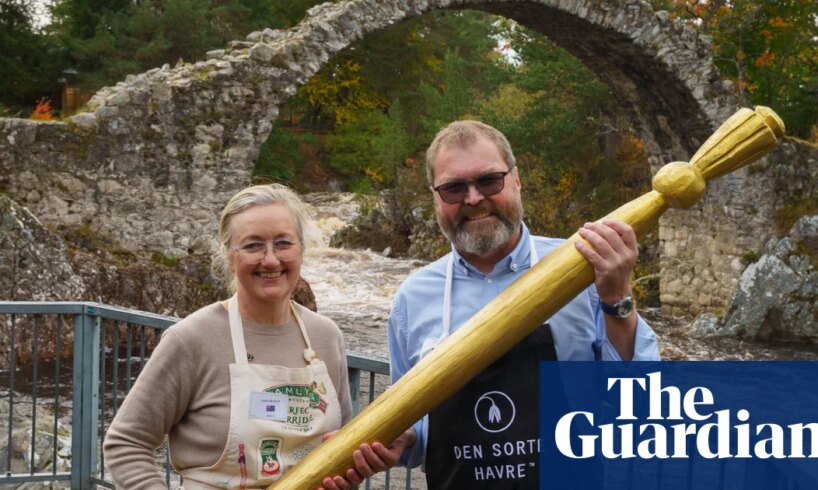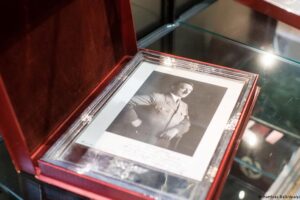
Only an Australian would bring a toastie to a porridge fight – and walk away with a trophy.
As other competitors stirred oats and debated salt ratios, the Melbourne food stylist Caroline Velik took out one of the top awards at this year’s World Porridge Making Championships in Carrbridge, Scotland.
Her yoghurt flatbread jaffle (better known internationally as a toastie), stuffed with rum bananas, Bundaberg banana toffee rum liqueur, bananas, oatmeal and wattle seeds and tossed in Davidson plum sugar, won the speciality dish category.
The win continues Australia’s hot streak in the competition: the Sydney chef Toby Wilson has twice reached the finals.
While Velik brought the flair, it was Sven Seljom from Mandal, Norway, who brought the tradition. Seljom claimed the coveted Golden Spurtle for best classic porridge with his minimalist bowl of rare Norwegian black oats, sea salt and water.
The ancient oats, once common across Europe before vanishing two centuries ago, made a triumphant return thanks to the first-time entrant’s method of soaking the organically grown grain for 24 hours.
Caroline Velik’s yoghurt flatbread with rum, bananas, oatmeal and wattle seeds. Photograph: Michael Harley
Velik, who was also the runner-up in the Golden Spurtle award, used her win to spruik the benefits of native Australian ingredients, saying she aimed to “bring the flavours of the Indigenous Aussie outback to Scotland”.
Adding wattleseed and Davidson plum ingredients to her mother’s nostalgic banana recipe, the creator also gave a nod to her native country’s convict history by decadently spiking the dish with the unofficial currency of the one-time British colony – rum.
Velik admits she arrived in Carrbridge as a seasoned contestant.
She first entered the competition in 2021, when it was held virtually due to the pandemic, submitting a steamed porridge featuring Australian native peach quandong, macadamia praline, mango, finger lime, bush honey and river mint.
In 2022, she returned in person with an oat congee, a savoury porridge inspired by south-east Asian flavours – “something we’re used to in Australia, but maybe not so much in the Highlands of Scotland”.
This year Velik fronted up with a battle-tested recipe and the scars of serious prep.
“I practised it in Australia first,” she told the Guardian. “A lot.”
Her plan hit a snag early on. Being a jaffle, bread was an essential ingredient of her creation. The competition’s committee, however, had strict rules: no premade ingredients. “That really threw a spanner in the works,” she said.
“I had to figure out how to make dough from scratch that would cook properly in the jaffle iron within the 30-minute time limit.”
skip past newsletter promotion
Sign up to Saved for Later
Catch up on the fun stuff with Guardian Australia’s culture and lifestyle rundown of pop culture, trends and tips
Privacy Notice: Newsletters may contain information about charities, online ads, and content funded by outside parties. If you do not have an account, we will create a guest account for you on theguardian.com to send you this newsletter. You can complete full registration at any time. For more information about how we use your data see our Privacy Policy. We use Google reCaptcha to protect our website and the Google Privacy Policy and Terms of Service apply.
after newsletter promotion
Velik with her award for best speciality dish. Photograph: Michael Harley
After extensive experimentation, Velik’s workaround became a quick yoghurt flatbread. The first few attempts were messy – “spewing out the sides” – but eventually she nailed the technique and the timing.
Three jaffles (one for each judge), 30 minutes. Two gas burners. A town hall kitchen in the middle of the Scottish Highlands.
“I had three different timers – five-minute timers, one-minute timers – just going for it, head down. It felt like I was on a cooking show.”
While making her winning 2025 dish, the Australian also had to explain to the Scottish MC, Sarah Rankin, the purpose of the unfamiliar iron implement she had deployed.
“A jaffle iron, you’ve made that up?” Rankin challenged.
“No no, jaffles were invented in Australia in the late 1940s,” Velik assured her.
New Zealanders may beg to differ: they have long insisted they got there first, calling their version of the jaffle iron a “quicksie”. The truth of the matter in this Pavlova-esque debate remains fluffy.
Velik says she believes it was the electric version of the 1940s stovetop creation that may or may not have originated in New Zealand. Either way the fast-food snack had become a staple on many an antipodean family’s menu by the mid-1970s.
Velik whipping up her specialty toastie. She says she practised the dish ‘a lot’ before the competition. Photograph: Michael Harley/Hamlyns of Scotland
The event’s “porridge chieftain”, Alan Rankin, told the media the standard in this elite competitive sport was “exceptional” this year.
“It’s wonderful to see the event continuing to go from strength to strength,” he said of the annual oat-off that this year attracted 30 entrants from 14 countries, after beginning as an innovative way to draw visitors to the sleepy Highland village during the quiet season back in 1994.
The humble spurtle – the wooden stick used to stir the dish without clumping in the pot – became the holy grail of porridge making excellence.
According to the Golden Spurtle annals, rules were strict in the fledgling competition. Only oatmeal, water and salt were allowed. No milk. No sugar. No fancy toppings. Just pure porridge, made the old-fashioned way.
Each year more competitors arrived, from across the UK, then Europe, then the rest of the world. By the 2000s the event had grown into a full-blown international championship but it wasn’t until 2009 that the speciality category was added to the pot, ever-stretching the definition of porridge.
With the oats now swept from the floor, Carrbridge returns to its peaceful pace. Until next year, when the porridge wars resume. Possibly with lamingtons.
In the meantime, if you wish to celebrate Velik’s achievement, the recipe can be found here.




